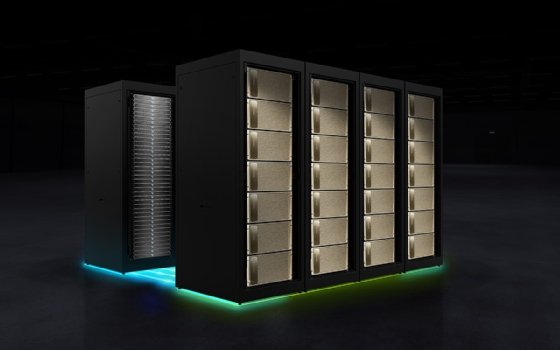
Getty Images
Vast Data unveils new storage platform built on Nvidia DPUs
Vast Data's Ceres combines the vendor's Universal Storage system with data processing units, which provide denser, more efficient storage targeted at AI workloads.
Vast Data is using data processing units from Nvidia to create a new storage system that takes Vast's storage software and delivers it in a denser package for consolidating data-intensive workloads.
Ceres uses Vast's Universal Storage software and Nvidia's BlueField DPUs, a hardware accelerator used primarily for big data and AI data processing. For storage capacity, Ceres uses E1.L SSDs, an Enterprise and Data Center SSD Form Factor designed for data center NVMe SSDs. The drives are long and thin, enabling higher density and better cooling, and allowing for more capacity per rack unit than U.2 form factor SSDs.
Vast's Ceres is further evidence of the company's strategic -- and timely -- focus on data-intensive workload consolidation, according to Eric Burgener, an analyst at IDC.
"AI-driven analytics is the fastest-growing workload over the next five years," he said, citing IDC's forecast of growth of different workloads.
Deploying AI workloads will cause enterprises to think differently about storage, blending new requirements such as parallel file systems with longstanding requirements such as snapshots, encryption, data reduction, quality of service and replication, Burgener said. Appliances like Ceres will provide enterprise requirements while supporting a parallel file system needed for data-intensive workloads.

A hardware push
Available now, Ceres is a dense 1U form factor storage appliance. Vast will provide two versions of the appliance: The first is a data center version made with original design manufacturer (ODM) AIC Inc.; the second is a ruggedized version made by Mercury Systems.
Vast uses ODMs to design the hardware it sells, providing specific requirements, according to Jeff Denworth, co-founder and chief marketing officer of Vast Data.
"We're not sourcing off-the-shelf stuff from companies like Supermicro," Denworth said. "In this case, we made a call to the industry to build something different."
Vast's previous chassis, LightSpeed, had serviceability from the sides. Ceres will be serviced from the front and back, no longer needing to be taken out of the rack, according to Daniel Bounds, vice president of marketing at Vast Data.
The release of a data center appliance muddies the waters on Vast's push to be a software-only storage provider, according to Chris Evans, an analyst at Architecting IT. Software-defined storage suggests the technology can be put on anything.
Bounds said Vast's push into software is still going strong.
A deeper look at density
Vast recently increased its density to 1 PB per 1U with the addition of 30 TB quad-level cell (QLC) SSD drives. Ceres has better density per appliance than the LightSpeed chassis in a 1U form factor with 675 TB of raw storage and 1.79 PB of effective storage after its similarity-based data reduction, which combines similar blocks of data in a cluster together, according to the vendor.
"We still have the same level of capacity density -- now we're just packing that into one rack unit instead of two," Bounds said.
To provide that kind of storage density in a small form factor, the vendor is using 22 E1.L QLC SSDs that are just over 12.5 inches long. Currently, the appliance is shipping with 15 TB SSDs with support for 30 TB in the future, Bounds said. The SSDs now use the PCIe Gen 4 interface, an upgrade from Gen 3. Ceres currently supports QLC SSDs, and Vast plans to support penta-level cell when the technology is available.
In between the E1.L SSDs is a midplane with U.2 storage class memory drives, which helps QLC operate efficiently.
"The problem is that there's no storage class memory options for E1.L in the market," Denworth said. "So we had to accommodate systems architectures that can support both."
The ruggedized version of Ceres, designed for military and edge deployment, is the same appliance but folded in half, with the front and back end on one side, Denworth said.
Ceres brings outsized performance in 1U
The rear of the appliance contains DNodes, or data nodes, that control the QLC drives. The appliance includes two DNode trays with two nodes each, Bounds said. Each tray has an Nvidia BlueField-1 BF1600 DPU and two 100 GbE ports. All parts are hot-swappable, making the appliance more serviceable without interruption. If a drive fails or a node goes out, Ceres will keep running as new parts are swapped in.
Vast's use of DPUs is the first practical use case Evans has seen for the processing units.
"A DPU is very lightweight -- it takes a lot less power than the CPU does," Evans said. "They're also programmable. [Users can] make it very platform-specific, rather than being a general CPU."
Instead of relying on a dual controller with CPUs and memory, Vast is using a DPU in each DNode tray instead of general CPUs as an accelerated way of running storage, Evans said.
IDC's Burgener also stated that DPUs provide greater efficiency for the kinds of data-intensive tasks Vast is targeting. The Nvidia BlueField DPUs can hit up to 60 GBps of throughput from a single node. With Ceres' clustered environments, data is spread across multiple nodes, and the performance can scale.
Performance numbers from Vast are 64 GBps read and 10 GBps write, according to the vendor.
Storage for SuperPod
Vast is now in the process of certifying Ceres for Nvidia's DGX SuperPod supercomputer, which provides storage and network performance, as well as high availability for large-scale AI workloads.
Vast's disaggregated, shared everything cluster architecture allows every node to be an independent operator where no two need to communicate as the nodes use the same shared pool of SSDs, making it a good fit for the SuperPod, according to Vast.






